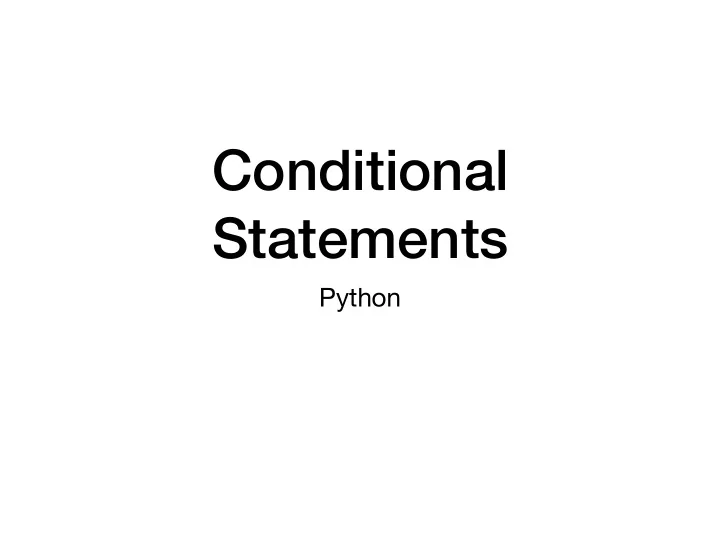

Conditional Statements Python
Conditional Statements • Sometimes a statement (or a block of statements) should only be executed if a condition is true. • Conditional execution is implemented with the if- statement • Form of the if-statement: if Condition : Statement one indent
Conditional Statements if : Condition Statement one indent • if — is a keyword • Condition: a Boolean, something that is either True or False • Statement: a single or block of statements, all indented • Indents are tricky, you can use white spaces or tabs, but not both. Many editors convert tabs to white spaces • The number of positions for the indent is between 3 and 8, depending on the style that you are using. Most important, keep it consistent.
Example • First line asks user for integer input. • Second line checks whether user input is smaller than 5. • In this case only, the program comments on the number.
Example • Here we calculate the absolute value of the input. • The third line is indented. • The fourth line is not, it is always executed.
Example • Here, lines 3 and 4 are indented and are executed if the input is a negative integer. • The last line, line 5, is always executed since it is not part of the if-statement
Alternative statements • Very often, we use a condition to decide which one of several branches of execution to pursue. • The else-statement after the indented block of an if- statement creates an alternative route through the program.
Alternative Statements • The if-else statement has the following form: if Condition : Statement Block 1 one indent else : Statement Block 2 one indent • We add the keyword else, followed by a colon • Then add a second set of statements, indented once • If the condition is true, then Block 1 is executed, otherwise, Block 2.
Examples • I can test equality by using the double = sign. • To check whether a number n is even, I take the remainder modulo 2 and then compare with 0.
Alternative Statements • Often, we have more than two alternative streams of execution. • Instead of nesting if expressions, we can just use the keyword “elif”, a contraction of else if.
Alternative Statements if Condition 1 : Statement Block 1 one • One of the statement indent blocks is going to be elif Condition 2 : executed Statement Block 2 one indent • The else block contains . the default action, if . none of the conditions . are true else : Statement Block n one indent
Alternative Statements • Here, there is no else if : Condition 1 statement, so it is Statement Block 1 one possible that none of indent the blocks is executed. elif : Condition 2 Statement Block 2 one indent . . . elif Condition n : Statement Block n one indent
Examples • Categorization of temperatures if temperature < -25.0: feeling = "arctic" elif temperature < -10.0: feeling = "Wisconsin in winter" elif temperature < 0.0: feeling = "freezing" elif temperature < 15.0: feeling = "cold" elif temperature < 25.0: feeling = "comfortable" elif temperature < 35.0: feeling = "hot" elif temperature < 45.0: feeling = "Ahmedabad in the summer" else: feeling = "hot as in hell"
Boolean Expressions • Nested loops to implement decision tree: x<10 No Yes if x<10: if y<3: if x<2: result=0 else: y<2 y<3 No No Yes Yes result=1 else: result=0 result = 1 result = 0 result = 0 else: x<2 if y<2: No Yes result=1 else result=0 result = 1 result = 0
Recommend
More recommend